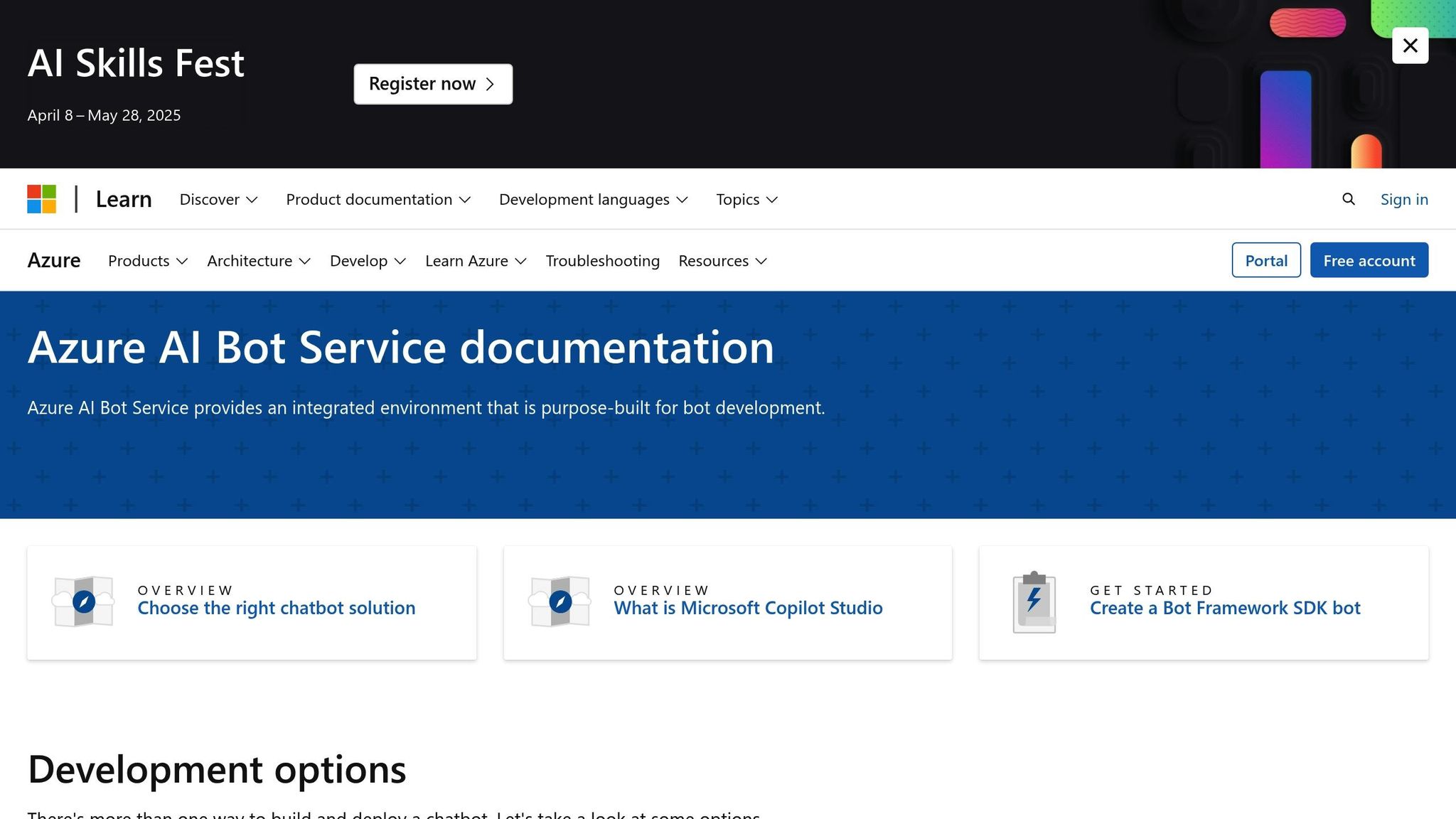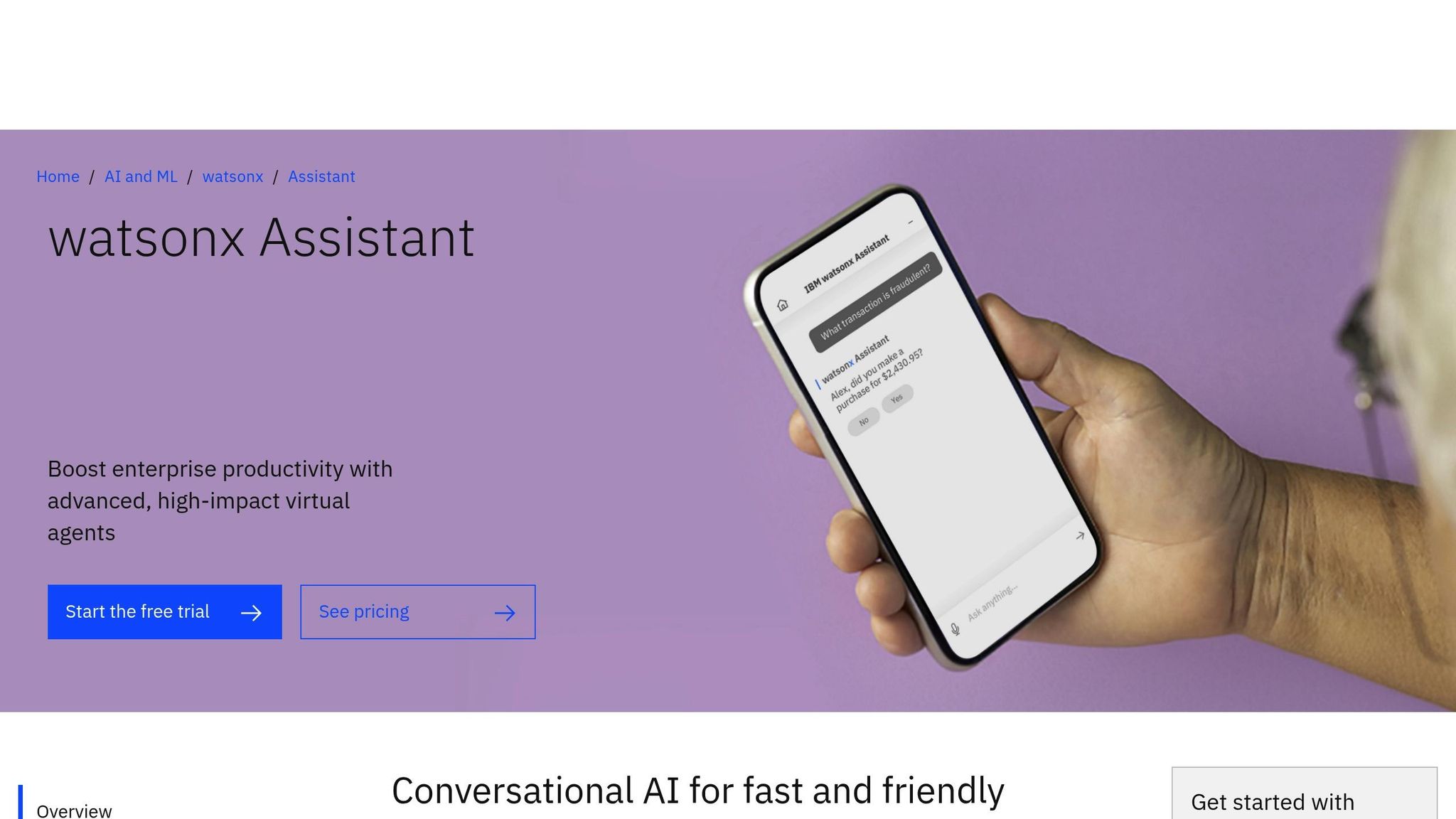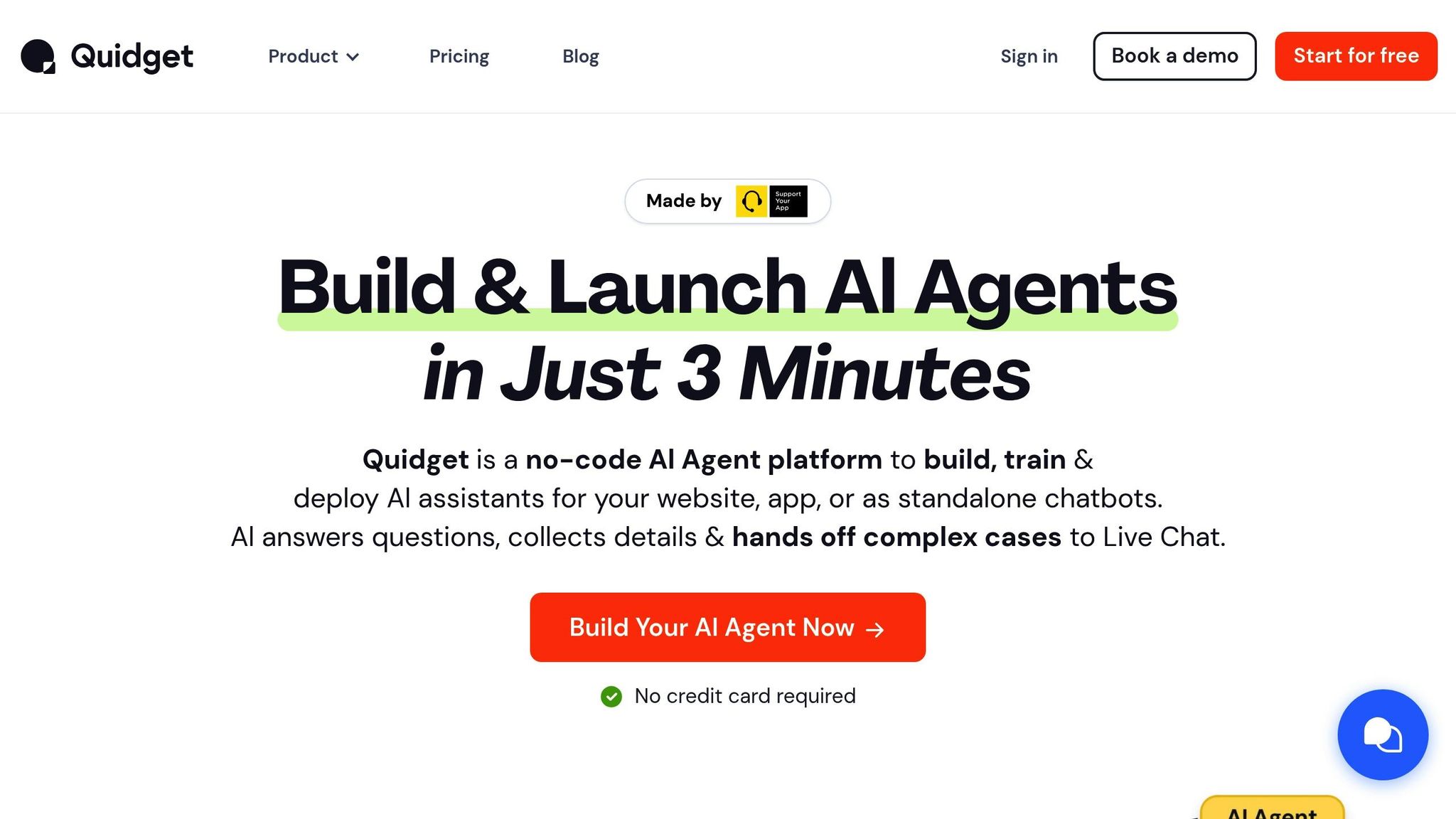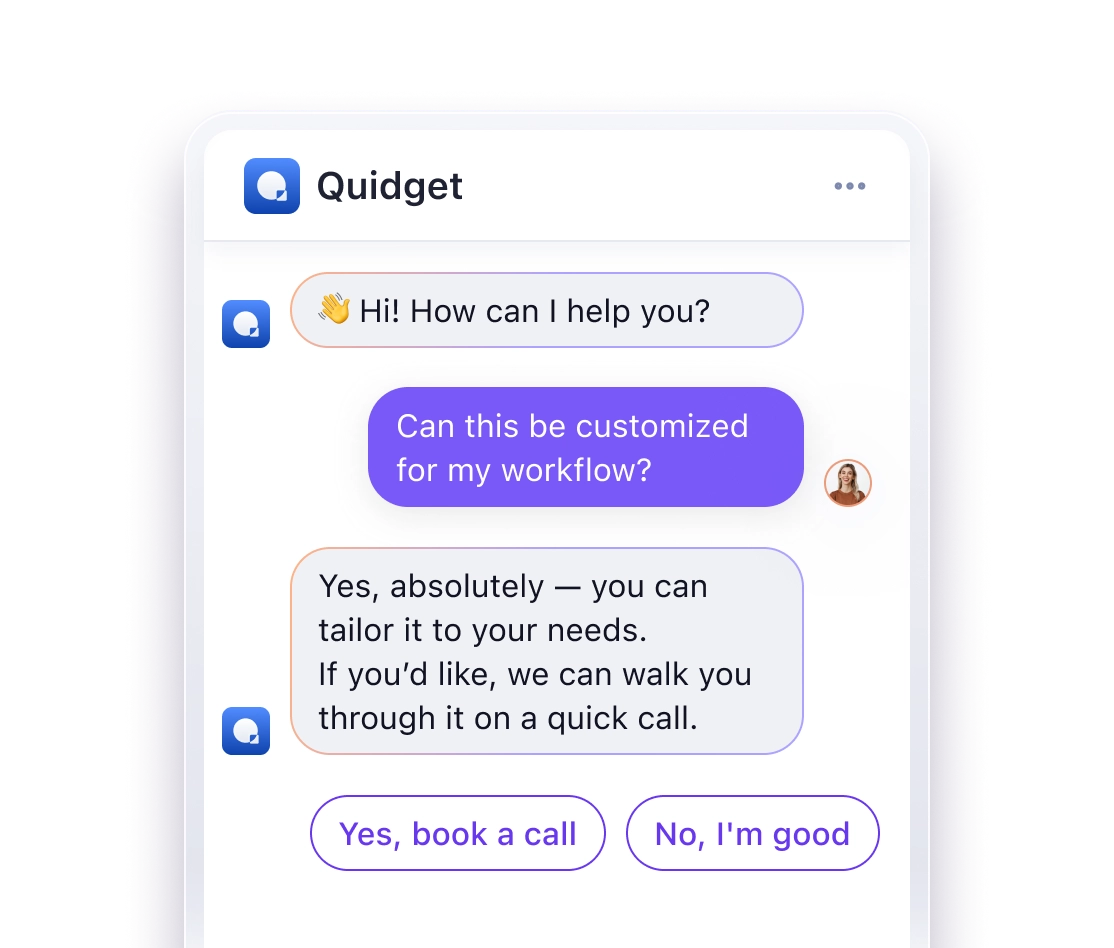Enterprise Chatbot Solutions: Choosing the Right AI for Large Businesses
- What They Are: Enterprise chatbots are AI-powered tools designed to handle complex tasks, automate processes, and provide 24/7 support for large-scale businesses.
- Key Benefits:
- Resolve 80% of common queries
- Reduce operational costs by 30%
- Improve service capabilities, workflows, and customer satisfaction
- Features That Matter:
- Multi-language support
- Integration with CRMs and business platforms
- Advanced security for sensitive data
- Scalability for high traffic
- Top Platforms:
- Microsoft Bot Framework: Scalable, multi-channel support
- IBM Watson Assistant: Advanced NLP and machine learning
- Quidget AI Agent Builder: No-code tools with multi-channel deployment
Quick Comparison of Basic vs. Enterprise Chatbots
| Feature | Basic Chatbot | Enterprise Chatbot |
|---|---|---|
| Decision Making | Rules-based | Learns and adapts |
| Functionality | Single-purpose | Multi-departmental |
| Response Type | Reactive | Anticipates user needs |
| Scalability | Limited | Handles enterprise scale |
| Security | Basic safeguards | Advanced protocols |
Why It Matters:
Chatbots save time, cut costs, and improve efficiency. For example, businesses like Photobucket and Hello Sugar have automated up to 66% of tasks, saving thousands monthly while scaling operations.
To get started, define your goals, design chat flows, and choose a platform that meets your needs. Platforms like Quidget offer free trials to help you build and test your chatbot with ease.
Business Impact of Enterprise Chatbots
24/7 Customer Support
Enterprise chatbots ensure around-the-clock assistance for customers. For example, Photobucket uses Zendesk AI agents to handle 94% of common queries instantly and resolve 10% of conversations without needing human involvement.
"The Zendesk AI agent is perfect for our users [who] need help when our agents are offline. They can interact with the AI agent to get answers quickly. Instead of sending us an email and waiting until the next day to hear from us, they can get answers to their questions right away."
– Trishia Mercado, director of member engagement team at Photobucket
This round-the-clock availability not only enhances customer experience but also helps reduce operational costs.
Cost and Resource Savings
Chatbots are a game-changer when it comes to cutting costs. Globally, chatbot implementations have already saved businesses about $20 million, with estimates suggesting annual savings could surpass $8 billion.
| Cost Factor | Impact |
|---|---|
| Staffing Costs | Staffing accounts for 65–70% of call center operating expenses. |
| Call Handling | Outbound calls via chatbots cost 33% less than inbound ones. |
| Automation Potential | Up to 29% of customer service roles could be automated. |
| Cost per Interaction | Saves up to $0.70 per automated conversation. |
Hello Sugar’s experience highlights these benefits. Their chatbot implementation achieved a 66% automation rate, saving $14,000 per month. This allowed them to scale operations without adding more staff.
"We currently have 81 salons and are going to grow to 160 this year – without growing our reception staff. And with automation, we’re able to do that while offering way better CX and getting higher reviews."
– Austin Towns, chief technology officer at Hello Sugar
Leveraging Customer Data and Insights
Chatbots do more than just answer questions – they gather valuable data from customer interactions. By tracking behavior, they can:
- Monitor customer sentiment in real time.
- Predict churn by analyzing patterns.
- Adjust inventory based on demand trends.
- Personalize services using usage data.
These insights help businesses make informed decisions and improve overall service delivery.
How to tackle an AI Chatbot project for enterprises (step-by-step)
Must-Have Enterprise Chatbot Features
Enterprise chatbots don’t just enhance interactions – they also play a key role in supporting business operations.
AI and Language Processing
For enterprise chatbots to handle complex conversations, they need advanced AI capabilities. Natural Language Understanding (NLU) is a critical component, allowing the chatbot to interpret and respond to customer intent effectively.
These AI-driven tools can:
- Handle multiple languages to support global users
- Understand context in multi-turn conversations
- Learn from past interactions to refine future responses
In addition to language processing, these chatbots must seamlessly integrate with business systems to provide meaningful and efficient interactions.
Business Software Integration
Enterprise chatbots thrive when integrated with business systems. They can access real-time data to enhance functionality – like retrieving customer details from CRMs, checking inventory levels, or automatically updating support tickets.
Take the Mailchimp–Spotify integration as an example. Their email verification system cut bounce rates from 12.3% to 2.1% in just 60 days. This improvement boosted deliverability by 34%, contributing $2.3 million in additional revenue.
As chatbots become more ingrained in business processes, ensuring data security and compliance is non-negotiable.
Data Protection and Standards
Since enterprise chatbots often deal with sensitive customer data, robust security measures are a must. Here are some key security features:
| Security Feature | Purpose |
|---|---|
| End-to-end encryption | Safeguards data during transmission |
| Access controls | Restricts data visibility |
| Audit logging | Monitors and records system activity |
| Compliance monitoring | Ensures adherence to regulations |
| Data retention policies | Manages how long data is stored |
With the AI chatbot market projected to hit $455 million by 2027, businesses must prioritize strong security measures to protect sensitive information while staying compliant with industry regulations.
sbb-itb-58cc2bf
Leading Enterprise Chatbot Platforms
Microsoft Bot Framework

Microsoft’s Azure AI Bot Service offers a secure and scalable solution for building chatbots that can operate across multiple channels. For instance, the Miami Dolphins utilized this platform to manage 40,000 fan interactions and successfully resolved 97% of inquiries.
"One of the great things about Bot Service is that, out of the box, we could use it to quickly put together the basic framework for our bot" – Matt White from Progressive Insurance
"We used Azure AI Services and Microsoft Bot Framework to deliver an instantly responsive, personal expert into our customers’ pockets. Providing this constant access to help is key to our customer care strategy" – Paul Jacobs, Group Head of Operations Transformation at Vodafone
Key features include:
- Microsoft Copilot Studio for low-code chatbot development
- Deployment across multiple channels, such as Teams and telephony
- Built-in tools for analytics and telemetry tracking
- Premium channels with pay-per-message pricing
Now, let’s look at IBM Watson Assistant, which takes a different approach by focusing on advanced natural language processing.
IBM Watson Assistant

IBM Watson Assistant brings powerful AI capabilities to the table, making it ideal for handling complex business needs. Its strengths lie in natural language processing and machine learning, offering features like multi-channel integration, context-aware replies, and seamless escalation to human agents.
Quidget AI Agent Builder

Quidget’s AI Agent Builder provides a no-code solution aimed at simplifying business operations. Designed to handle up to 80% of Tier-1 customer support inquiries in over 45 languages, it’s a suitable choice for global enterprises.
| Feature | Business Impact |
|---|---|
| Multi-channel Support | Deployable on platforms like WhatsApp, Slack, Telegram, and Viber |
| Live Chat + AI Handoff | Combines automated responses with human support for a smooth customer experience |
| Advanced Analytics | Monitors performance and identifies customer interaction trends |
| Enterprise Integration | Connects with tools like Zendesk, Calendly, and custom systems |
One standout feature of Quidget is its Sales AI agent, which simplifies lead collection and automatically schedules calls through Calendly integration. This reduces the time needed for sales processes and improves efficiency.
Building Your Chatbot Plan
Setting Goals and Uses
Before diving into development, outline clear objectives that match your business needs. Identify the specific tasks your chatbot will handle, whether it’s customer support, lead generation, or assisting with sales. Focus on measurable outcomes like response times, resolution rates, lead capture efficiency, or ticket deflection rates. Establish a realistic timeline with performance benchmarks to track progress and justify your investment. Once your goals are set, design chat flows that align with these targets.
Creating Chat Flows
A well-structured chat flow keeps users engaged and guides them to the solutions they need. Here are some essential components to consider when designing your flows:
| Flow Component | Purpose | Best Practice |
|---|---|---|
| Welcome Message | Sets the tone for the interaction | Clearly identify as AI and outline your chatbot’s purpose and capabilities. |
| Response Options | Guides user choices | Offer 3-4 clear, concise options to streamline navigation. |
| Fallback Paths | Handles unexpected inputs | Include a human handoff option for complex or unresolved queries. |
| Exit Points | Ends conversations effectively | Gather feedback and provide next steps or additional resources. |
Keep messages short and give users enough time to respond. This helps create a natural conversational flow and improves the overall experience.
AI Training Methods
Once your chat flows are ready, train your AI using your core business data and refine it over time with user feedback. Start with these training sources: your company knowledge base, FAQs, support ticket history, product documentation, and sales materials.
To keep improving, follow these steps:
- Data Collection: Monitor user interactions and feedback to identify strengths and areas for improvement.
- Performance Analysis: Track metrics like response accuracy and user satisfaction to understand where the chatbot excels and where adjustments are needed.
- Content Updates: Regularly update training materials with new FAQs and business changes to ensure the chatbot stays relevant.
Combine automated learning with human oversight for the best results. Regular reviews by subject matter experts can help maintain high-quality responses.
Common Enterprise Chatbot Problems
Managing High Usage
Handling heavy traffic demands a solid infrastructure and smart resource management. Here’s how to tackle common challenges:
| Component | Challenge | Solution |
|---|---|---|
| Server Load | Traffic surges | Use auto-scaling architecture to manage sudden increases in demand. |
| Delay Reduction | Slow response times | Implement caching for frequent queries and distributed processing. |
| Queue Management | Request bottlenecks | Introduce priority queues for critical conversations. |
Keep an eye on key metrics like response times, server load, and conversation completion rates. Set up alerts to catch and resolve issues quickly.
Once system performance is under control, it’s equally important to secure customer data.
Data Security Steps
Protecting sensitive customer information is non-negotiable. Follow these steps to ensure robust data security:
- Access Control Implementation
Limit data exposure by using role-based access control (RBAC). Assign specific roles and permissions for managing, training, and monitoring the chatbot. Regularly audit access to identify and remove unnecessary privileges. - Encryption Protocol Setup
Apply AES encryption to secure databases, API connections, chat logs, and training data. - Compliance Framework Integration
Ensure your security measures meet regulatory standards like GDPR for European users, CCPA for California residents, HIPAA for healthcare data, and SOC 2 for service organizations.
With data security in place, the next priority is delivering accurate and effective responses.
Improving Response Quality
The quality of your chatbot’s responses plays a huge role in user satisfaction and brand perception.
Here’s how to enhance response quality:
- Context Setting
Provide clear system prompts to define the chatbot’s purpose, tasks, and response format. - Quality Control Process
Review conversation logs, track resolution rates, and gather user feedback to identify areas for improvement. Update training data regularly. - Continuous Improvement
Test and update the chatbot frequently. Adjust responses based on new product details, policy changes, customer feedback, and recurring misunderstandings.
Summary and Getting Started
Key Takeaways
Building a successful enterprise chatbot relies on these crucial elements:
Core Features
- Handles natural, human-like conversations
- Integrates smoothly with business tools
- Ensures top-notch security and compliance
- Efficiently manages large-scale interactions
- Supports communication across multiple regions
Steps to Implement
- Define your business objectives
- Map out conversation flows
- Train the AI using your company’s data
- Launch and test the chatbot
- Continuously monitor and refine its performance
Following this plan sets a clear path for creating an effective, AI-powered support system.
Get Started with Quidget’s Platform
Ready to bring your chatbot strategy to life? Quidget makes it simple.
- Start Your Free Trial
Enjoy 7 days of free access, which includes:- 50,000 AI responses per month
- 50 AI chatbots
- 5 user seats per chatbot
- Enterprise API access
- Advanced analytics tools
- Build Your Chatbot
Use Quidget’s intuitive tools to create a chatbot that fits your needs:- No coding required
- Pre-designed business templates
- Custom branding options
- Seamless tool integration
- Expand and Optimize
Scale your operations effortlessly with features like:- Automation of 80% of routine queries
- Multi-channel deployment capabilities
- Detailed performance insights
- Access to priority customer support
Take your customer support to the next level with AI. Start your free trial today – no credit card required – and get priority support from day one.



